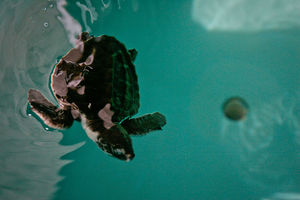
Until recently, the Kemp’s ridley sea turtle population was rebounding so well that scientists and conservationists fully expected the animal to swap its “endangered” status for “threatened” in the very near future — and possibly be taken off the endangered species list altogether by 2020.
According to Pamela Plotkin, director of Texas Sea Grant, the turtle’s numbers had been growing 12 to 17 percent each year thanks to conservation efforts, with population models projecting the same upward trend for the foreseeable future.
Then in 2010, the year of the BP oil spill disaster in the Gulf of Mexico, something big happened that caused Kemp’s ridley nesting on the beaches of Texas and Mexico to plummet, she said.
An updated population model, presented for the first time at the Second International Kemp’s Ridley Sea Turtle Symposium on Nov. 18 and 19 in Brownsville, confirmed that the population is no longer increasing but in fact is in steep decline.
“We have seen somewhere between a 40 and 50 percent decline in the number of nests that have been laid in Mexico, and we’ve seen similar a decline on the beaches in Texas,” said Plotkin, interviewed during the symposium.
Multiple factors
To what degree the oil spill is responsible for the turtle’s reversal of fortunes will probably never be known, she said. The consensus among experts, however, is that it was definitely a factor.
Another symposium presentation, based on National Resources Damage Assessment-funded research that sampled Kemp’s ridley skin and shells, revealed a “significantly different” chemical composition in turtles exposed to the spill compared to turtles that were not exposed.
Other NRDA-funded data is being held back pending resolution of the lawsuit against BP. When that data is released and researchers are able to speak more freely, Plotkin suspects “we’re going to see some linkage to the disaster.”
But that’s not all that’s been hurting the Gulf, she said.
“There are many things in the Gulf of Mexico that are stressing the ecosystem,” Plotkin said. “Since 2008, we’ve had some wild fluctuations in environmental conditions. There have been some years where we had so much freshwater coming down the Mississippi that it altered the salinity of the waters, and could have impacted the blue crab populations that the Kemp’s ridley feed on.”
This was followed by severe drought in 2011, which resulted in less freshwater and therefore greater salinity, or saltiness. These fluctuations impact the nursery grounds for blue crabs and other organisms the Kemp’s ridley depends on, Plotkin said.
Another problem that doesn’t get talked about much are the massive algae blooms — red and brown tide —that appear in the Gulf from Florida to South Texas and that also directly affect the sea turtles and the animals they feed on, she said.
“I like to describe it as a perfect storm in the last four to five years that we’ve had in the Gulf of Mexico,” Plotkin said. “There have been changes in oceanographic conditions, changes in atmospheric conditions. All of these together have impacts. Will we ever know what the relative impacts of each of those things have been on the turtles? Probably not.”
Loss of funding
In short, the Kemp’s ridley — which had dwindled to about 300 females by the mid-1980s before recovery efforts began — is again in serious trouble. As a result, conservation action is urgently needed, Plotkin said.
The prime example is a binational recovery program between the United States and Mexico developed in 1978 to protect and increase the production of the Kemp’s ridley at its natal beaches in Tamaulipas state, where the vast majority of the turtles nest.
In 1981, the U.S. Fish and Wildlife Service asked the Gladys Porter Zoo to administer the U.S. field portion of the program, which has long been funded through the USFW.
The fact that the federal government withdrew funding this year has conservationists like Plotkin scratching their heads (to say the least), considering the huge success of the binational program—and the fact that the Kemp’s ridley is once again in trouble.
“It doesn’t make logical sense,” Plotkin said. “Nobody has explained it other than as related to sequestration.”
Without the binational program, the sea turtles will be left unprotected with their eggs uncounted and uncollected and their hatchlings in jeopardy. Besides physically protecting the turtles, the field research that ongoing population assessments and projections rely on will come to a halt.
The only thing that saved the binational program this year was $150,000 in one-time emergency funds from the Gulf States Marine Fisheries Commission for the 2014 nesting season.
Steve Clark




